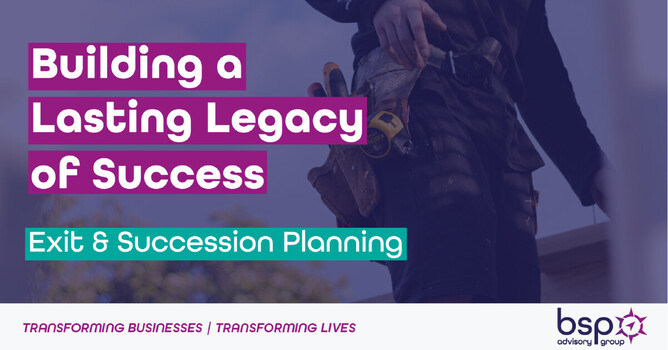Exit & Succession Planning is your Roadmap to Building a Lasting Legacy of Success.
Whether you're considering stepping back in the next five years or are looking to grow your business and secure its future, Exit and Succession Planning is a critical area deserving attention.
Learn what exit & succession planning is, why it matters and 6 key steps for effective exit and succession planning.
This article explains what exit and succession planning really is, why it matters, and how the STEP Programme gives NZ business owners a clear, structured path to the strongest possible future.
Exit and Succession Planning Explained
Exit and Succession Planning is developing a strategy that ensures your business is in its best possible position for growth, sale and/or change of leadership.
Whether it's now or years ahead, you will be in at least one of these scenarios:
You'll want to step back from the daily operations of your business, instead focussing on it's development and growth
If you've already stepped back, developing a cohesive business growth and wealth creation strategy is likely a priority
You will want to sell your business for the best possible price
You will want a business that's attractive to investors
You will want to ensure the transition from old owner to new; whether that's a buyer or family member, is seamless with a great outcome for all parties involved
Exit and Succession Planning is putting a framework in place to ensure the scenarios above happen with the best possible outcome.
This is exactly what the STEP Programme was built for.
How the STEP Programme Fits Into Exit & Succession Planning
Exit and succession planning becomes far more effective, predictable, and profitable when aligned to the three phases of the STEP Programme:
STEP Up — Build a stronger, more profitable business
This phase ensures the business is healthy, structured, systemised, and attractive to buyers or successors.
It includes:
Documented systems
Clean financials
Clear KPIs
Operational efficiency
Profit improvement
Stronger workflow and structure
A business cannot be sold — or handed over — at a premium until this foundation exists.
STEP Back — Reduce owner dependency and build leadership
This is the stage where real exit value is created.
It includes:
Leadership development
Clear roles and delegation
Team accountability
Removing the owner as the bottleneck
Creating a business that runs independently
Buyers will pay significantly more for a business that isn’t reliant on the owner — and successors perform best when they inherit a well-led, well-structured environment.
STEP Out — Prepare for transition, succession, or sale
Once the business is strong and leadership is in place, owners can confidently plan their exit.
STEP Out includes:
Succession pathway planning
Preparing for sale
Business valuation guidance
Structuring the transition
Legal and tax considerations
Owner role reduction
Communication and stakeholder alignment
Whether you sell, hand over internally, or move into passive ownership.
STEP Out ensures a clean, profitable transition.
Why exit and succession planning matters
Maximising Business Value
One of the primary reasons to engage in exit and succession planning is to maximise the value of your business. A well-structured plan ensures that your business remains attractive to potential buyers or successors by demonstrating stability, growth potential, and preparedness for a smooth transition.
This not only makes your business more valuable but also positions it to command a higher sale price or transfer value.
Ensuring Business Continuity
Unexpected events such as illness, economic downturns, or changes in personal circumstances can disrupt business operations. A sound exit plan ensures that your business can continue to operate effectively without you, maintaining stability and protecting your employees, customers, and legacy.
It provides a clear roadmap for successors, minimising disruptions and preserving the business’s operational integrity.
Aligning Business and Personal Goals
Exit and succession planning isn't just about the business; it's also about aligning your personal and financial goals with the future of your enterprise.
Whether your aim is to retire comfortably, pursue new ventures, or ensure your family is taken care of, a comprehensive plan helps bridge the gap between your business’s success and your personal aspirations. It allows you to transition smoothly into the next phase of your life, with confidence and financial security.
Enhancing Quality of Life
Proactively planning your exit can greatly enhance your quality of life. It provides the opportunity to gradually reduce your involvement in the business while ensuring that your life's work continues to thrive.
By having a succession plan, you can enjoy a balanced lifestyle, knowing that your business is in capable hands and your financial future is secure.
6 Steps for Effective Exit and Succession Planning
Start Early: Planning for your exit should begin well before you intend to leave the business.
Ideally, this process starts several years in advance to allow ample time for preparations, adjustments, and value enhancement. Early planning provides flexibility and allows you to explore various options without the pressure of imminent timelines.
Assess Business Readiness
Evaluate your business’s current state, identifying strengths, weaknesses, opportunities, and threats. Conduct a thorough analysis to determine areas that need improvement to make your business more attractive to potential successors or buyers. This might include financial health, operational efficiency, market positioning, and management structure.
Identify and Develop Successors
If you plan to pass your business to a family member or key employee, begin grooming your successor(s) early. Ensure they are equipped with the necessary skills, experience, and understanding of the business. This process may involve training, mentoring, and gradually increasing their responsibilities within the organisation.
Valuation and Financial Planning
Obtain a professional valuation of your business to understand its current worth. This will help you set realistic expectations and goals for the sale or transfer. Additionally, engage in financial planning to manage the proceeds from the sale or transition, ensuring that it aligns with your long-term financial goals.
Legal and Tax Considerations
Work with legal and financial advisors to address the legal and tax implications of your exit strategy. This includes structuring the sale or transfer to minimise tax liabilities, updating your estate plan, and ensuring compliance with relevant regulations.
Document the Plan
A formal, documented exit and succession plan is essential. It should outline the steps, timelines, responsibilities, and contingencies for the transition. This document serves as a reference for all parties involved, providing clarity and reducing uncertainty during the transition.
Communicate Transparently
Effective communication is key to a successful transition. Keep stakeholders informed about your plans, including employees, customers, suppliers, and family members. Clear communication helps manage expectations and fosters trust and confidence in the process.
Creating a Legacy of Success
In conclusion, exit and succession planning is not just about preparing for the end—it's about creating a lasting legacy of success.
It’s about ensuring that your business can thrive without you, providing for your future, and safeguarding the interests of all those connected to your enterprise. Whether you're planning to exit in the next five years or simply looking to be prepared, now is the time to start crafting a plan that aligns with your goals and secures your business’s future.




